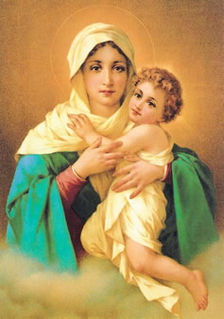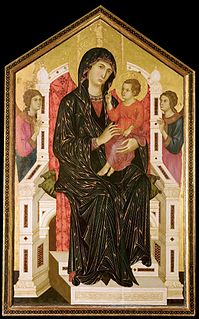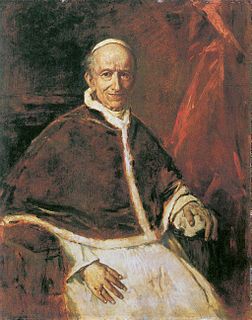
The Holy Rosary, also known as the Dominican Rosary, or simply the Rosary, refers to a form of prayer psalter used in the Catholic Church and to the string of knots or beads used to count the component prayers. When referring to the prayer, the word is usually capitalized ; when referring to the beads, it is written with a lower-case initial letter.

Pope Leo XIII was the head of the Catholic Church from 20 February 1878 to his death. He was the oldest pope, and had the third-longest confirmed pontificate, behind those of Pius IX and John Paul II.
The Camerlengo of the Holy Roman Church is an office of the papal household that administers the property and revenues of the Holy See. Formerly, his responsibilities included the fiscal administration of the Patrimony of Saint Peter. As regulated in the apostolic constitution Pastor bonus of 1988, the camerlengo is always a cardinal, though this was not the case prior to the 15th century. His heraldic arms are ornamented with two keys – one gold, one silver – in saltire, surmounted by an ombrellino, a canopy or umbrella of alternating red and yellow stripes. These also form part of the coat of arms of the Holy See during a papal interregnum. The camerlengo has been Kevin Farrell since his appointment by Pope Francis on 14 February 2019. The vice camerlengo has been Archbishop Ilson de Jesus Montanari since 1 May 2020.

The Litany of the Blessed Virgin Mary is a Marian litany originally approved in 1587 by Pope Sixtus V. It is also known as the Litany of Loreto, after its first-known place of origin, the Shrine of Our Lady of Loreto (Italy), where its usage was recorded as early as 1558.

The 1878 papal conclave, which resulted from the death of Pope Pius IX on 7 February 1878, met from 18 to 20 February. The conclave followed the longest reign of any other pope since Saint Peter. It was the first election of a pope who would not rule the Papal States. It was the first to meet in the Apostolic Palace in the Vatican because the venue used earlier in the 19th century, the Quirinal Palace, was now the palace of the King of Italy, Umberto I.

Our Lady of the Rosary, also known as Our Lady of the Holy Rosary, is a title of the Blessed Virgin Mary in relation to the Rosary.
The Secretariate of Briefs to Princes and of Latin Letters, or simply the Secretariate of Briefs, was one of the offices of the Roman Curia abrogated in 1967 during Pope Paul VI's reform of the Pontifical court. It was divided into two sections.

Rosarium Virginis Mariae is an Apostolic Letter by Pope John Paul II, issued on October 16, 2002, which declared October 2002 to October 2003 the "Year of the Rosary". It was published by Pope John Paul II in 2002 at the beginning of the twenty-fifth year of his pontificate.

The history of Catholic Mariology traces theological developments and views regarding Mary from the early Church to the 21st century. Mariology is a mainly Catholic ecclesiological study within theology, which centers on the relation of Mary, the Mother of God, and the Church. Theologically, it not only deals with her life but with her veneration in life and prayer, in art, music, and architecture, from ancient Christianity to modern times.

The Mariology of the popes is the theological study of the influence that the popes have had on the development, formulation and transformation of the Roman Catholic Church’s doctrines and devotions relating to the Blessed Virgin Mary.

Mariological papal documents have been a major force that has shaped Roman Catholic Mariology over the centuries. Mariology is developed by theologians on the basis not only of Scripture and Tradition but also of the sensus fidei of the faithful as a whole, "from the bishops to the last of the faithful", and papal documents have recorded those developments, defining Marian dogmas, spreading doctrines and encouraging devotions within the Catholic Church.

Catholic Marian movements and societies have developed from the veneration of the Blessed Virgin Mary by members of the Catholic Church. These societies form part of the fabric of Mariology in the Catholic Church. Popular membership in Marian organizations grew significantly in the 20th century, as apparitions such as Our Lady of Fátima gave rise to societies with millions of members, and today many Marian societies exist around the world. This article reviews the major Marian movements and organizations.

During his pontificate, Pope Leo XIII wrote twelve encyclicals and five apostolic letters on the Rosary. The first such encyclical was Supremi apostolatus of September 1883. Most were issued in September in anticipation of October, which Leo would have dedicated to special devotion to Mary, in particular through the Rosary.

The exact origins of both the rosary and scapular are subject to debate among scholars. Pious tradition maintains that both the rosary and the brown Scapular of Our Lady of Mount Carmel were given by the Virgin Mary to saints Dominic and Simon Stock respectively during the 13th century. Historical records document their growth during the 16th and 17th centuries in Europe. By the early 20th century, they had gained such a strong following among Catholics worldwide that Josef Hilgers, writing in the Catholic Encyclopedia of 1914, stated: "Like the Rosary, the Brown scapular has become the badge of the devout Catholic."

The Scapular of Help of the Sick is a Roman Catholic devotional scapular originating in 1860.

Consueverunt Romani Pontifices is a papal bull by Pope Pius V issued on September 17th, 1569 on the rosary. This papal bull instituted the essence of the rosary's present configuration.
The Rosary is one of the most notable features of popular Catholic spirituality. According to Pope John Paul II, rosary devotions are "among the finest and most praiseworthy traditions of Christian contemplation." From its origins in the twelfth century the rosary has been seen as a meditation on the life of Christ, and it is as such that many Popes have approved of and encouraged its recitation.

Louis-Marie Grignion de Montfort was a French Roman Catholic priest and Confessor. He was known in his time as a preacher and was made a missionary apostolic by Pope Clement XI.

Our Lady of the Most Holy Rosary- La Naval de Manila is a venerated title of the Blessed Virgin Mary associated with the same image in the Philippines.















